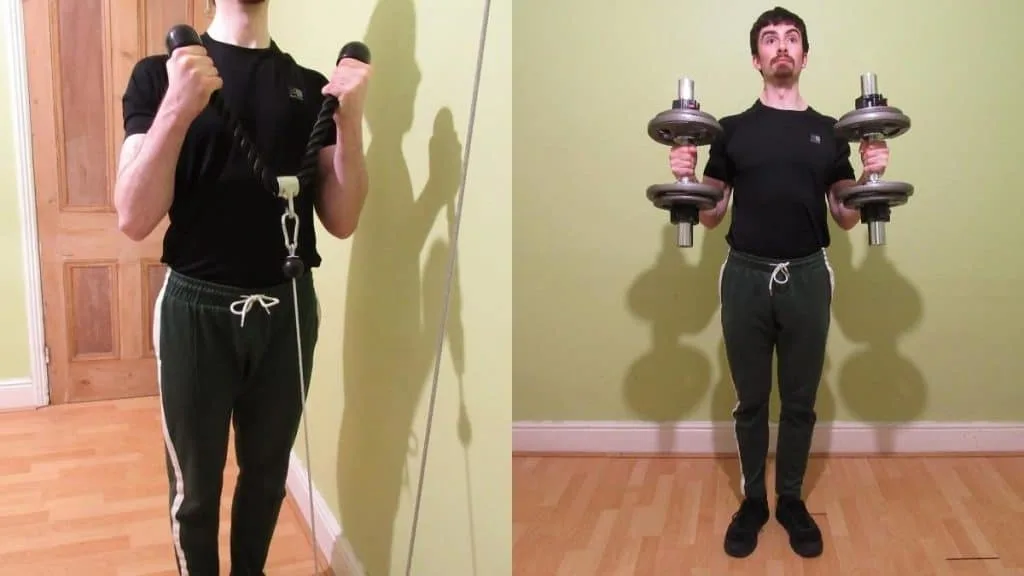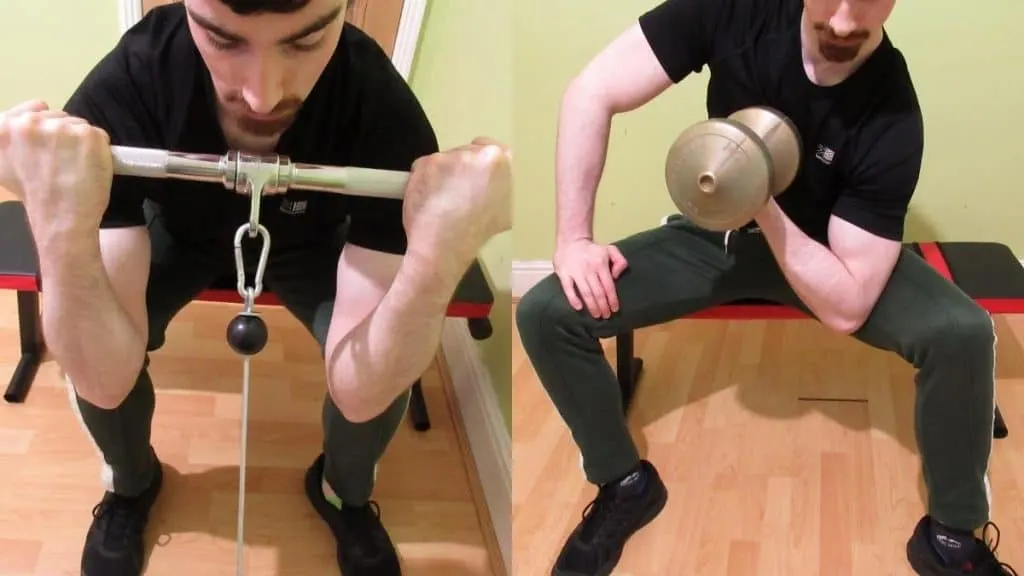The standing cable curl is a great exercise to work your bicep muscles because, unlike free weights, cables provide constant tension. But is it as effective as DB bicep curls for building muscle and developing strength?
Let’s find out.
We’ve split our cable curls vs dumbbell curls comparison into different sections because, as you might have guessed, each exercise has its pros and cons.
So if you’re wondering which is the most effective for muscle growth or which is best for the pump, and so on, then you can easily find what you’re looking for by scrolling to the section that’s most relevant to your goals.
As for whether you should do cable curls or barbell curls, we also have a guide on that since many people have been wondering which is best for their biceps.
The main differences
- Dumbbell curls are the hardest when your arm is flexed to 90 degrees.
- Cable curls provide constant and more consistent tension.
- Cables are easier to microload because you can add fractional plates to the stack (important for a relatively small and weak muscle like the biceps).
- Dumbbells typically have larger weight jumps than cables.
- Dumbbells are more widely available (and cheaper if you train at home).
- Cable curls are a bit easier on your joints.
Which is the most effective for muscle growth?

We know from research that training volume, which is the total amount of weight that you lift over a given workout, week, or mesocycle, is the most important factor in the muscle growth equation. [1]
Therefore, as long as you’re gaining strength and consuming enough protein and healthy calories, then you’re likely gaining muscle mass as well.
However, is it possible for two exercises to provide the exact same rates of muscle growth?
Probably not. But the differences in muscle growth potential between cable curls and dumbbell curls are likely so minute that you’d never be able to detect them.
Still, cables provide constant tension, whereas dumbbells don’t because the pulley system exerts force from the moment that you lift the weights off the stack right until you lower them again at the end of your set.
So if tension is the most essential prerequisite for muscle growth, then we could argue that cable curls are better than dumbbell curls.
Dumbbells, however, have been around for much longer than cables. As such, they have a far stronger track record for building impressive biceps. So if you want a sure thing, then you should probably stick with free weights for now.
Which is better for strength development?

Strength is a muscle’s ability to produce force. [2] So you can get strong regardless of whether you choose cables or dumbbells for your curls. But if we’re talking about which exercise has the most strength carryover to other movements, then it’s definitely dumbbells.
This is because your biceps have to stabilize free weights all by themselves. But with cables, the machine helps you to stabilize the weight to an extent.
Now, this may actually be advantageous for muscle growth, but if you want to increase your strength on other free weight movements, then you should also use free weights for the majority of your assistance exercises.
Which one provides the better pump?

This one’s easy. Cable curls elicit a more powerful muscle pump than dumbbells because they provide your biceps with constant tension.
So, since your biceps don’t have any time to rest during the set, they become engorged with blood and temporarily larger and more inflated due to the cell swelling effect of repeatedly stretching and contracting the muscle fibers.
Dumbbells can still give your biceps a good pump. However, if you pause at the bottom of the rep, then you’re undeniably taking tension off the muscle.
Of course, there’s a lot more to muscle growth than just getting a good pump, so don’t let this deter you if you prefer lifting free weights for your biceps.
If you’re looking for a full bicep workout with cables that you can perform for muscle growth, then you can click the link to see a comprehensive list of exercises. Or feel free to keep reading this comparison to stay on the free weight side of things.
Which exercise should you perform first?

Due to providing more of a muscle pump, cables are naturally a fantastic finishing exercise.
So for this reason, it’s recommended to begin your workout with heavy dumbbell curls to train the fast-twitch muscle fibers, which are the fibers that grow the biggest and the strongest.
Then you can end your session with some pump work to target the remaining slow-twitch muscle fibers that you didn’t get a chance to recruit with your heavier bicep curls.
Ultimately, while dumbbells are certainly a good substitute for cable curls, the most important thing is that you gain strength over time.
Because if you’re getting stronger week to week or month to month, and you’re also gaining bodyweight, then you can be fairly certain that your muscles are also getting bigger.
Related exercise: Cable alternating curls
Cable curls vs dumbbell curls: The verdict

The cable curls vs dumbbell curls debate has been raging ever since the pulley system became a permanent fixture in gyms and health clubs.
Old school lifters prefer dumbbells because of their proven track record in building show-winning biceps.
However, those who love getting a good pump invariably gravitate toward cables because they provide a more potent muscle pump.
For the best results, it’s recommended to perform both exercises. This way, you get the heavy, fiber-tearing tension that free weights provide, but you also get the pump and burn that cables always deliver.
References
- Sooneste, H., Tanimoto, M., Kakigi, R., Saga, N., & Katamoto, S. (2013). Effects of Training Volume on Strength and Hypertrophy in Young Men. Journal of Strength and Conditioning Research, 27(1), 8–13. https://doi.org/10.1519/jsc.0b013e3182679215
- Suchomel, T. J., Nimphius, S., Bellon, C. R., & Stone, M. H. (2018). The Importance of Muscular Strength: Training Considerations. Sports Medicine, 48(4), 765–785. https://doi.org/10.1007/s40279-018-0862-z

